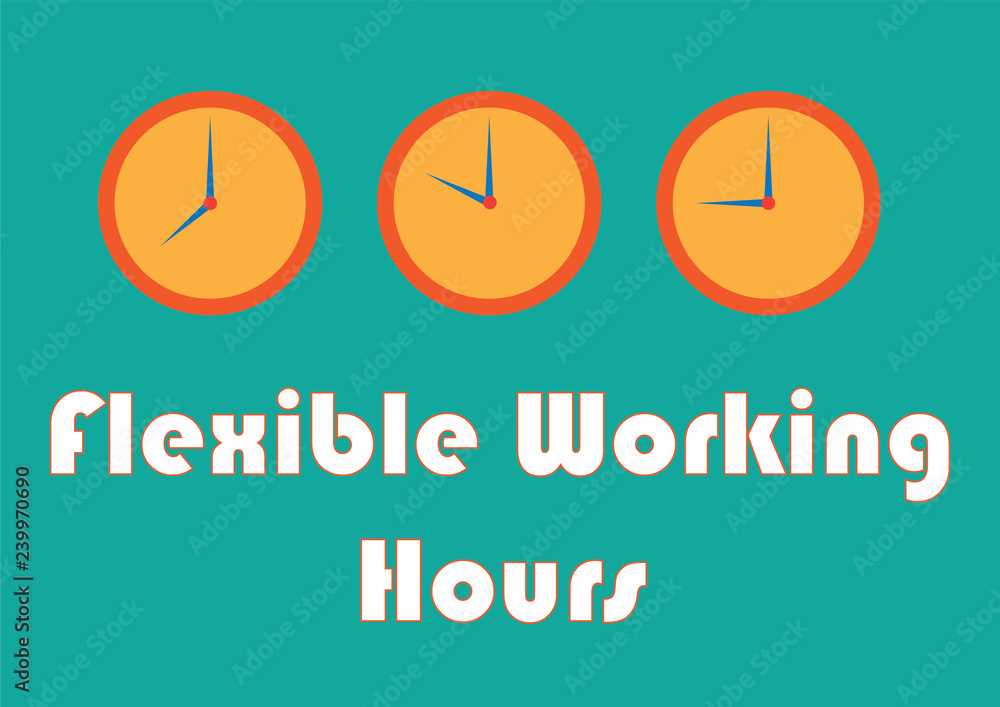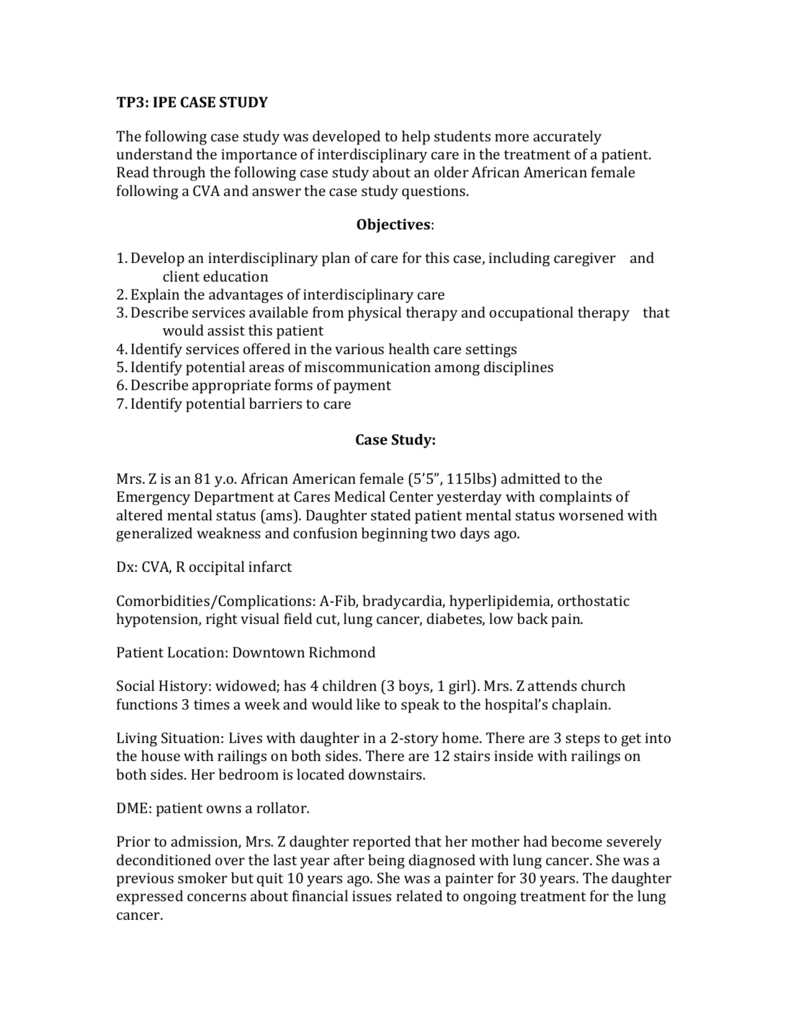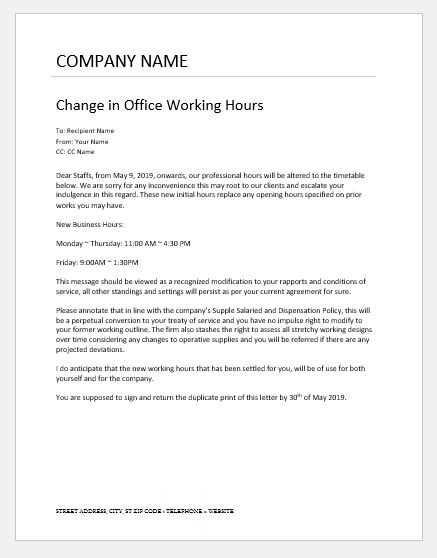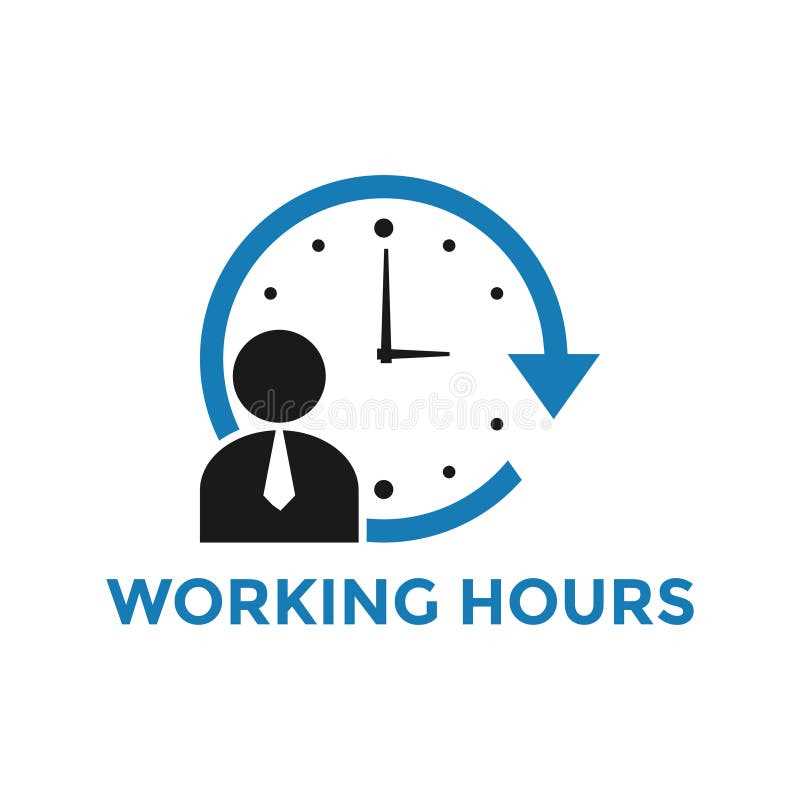Flexible Working Hours Template Letter for Easy Requests

In today’s fast-paced world, many individuals seek a better balance between their professional responsibilities and personal life. As a result, a growing number of employees are requesting changes to their traditional daily routines. This shift allows them to manage their commitments more efficiently while maintaining productivity at work.
Creating a formal document for such a request is essential, as it helps establish clear expectations between the employee and employer. An effective communication method is key to making the case for a schedule change that aligns with both personal needs and business objectives.
Understanding the right way to approach your employer can increase the likelihood of a favorable response. A well-structured request will not only highlight the reasons for the change but also demonstrate how the new arrangement can benefit the organization.
Why Flexible Working Hours Matter
In the modern workplace, employees are increasingly seeking greater control over their daily schedules. The traditional 9-to-5 structure may no longer align with everyone’s personal or professional needs. This shift towards a more adaptable approach to job hours benefits both employees and employers, fostering a more balanced and productive work environment.
Improved Work-Life Balance
One of the key reasons for this shift is the enhancement of work-life balance. By allowing staff to manage their schedules, individuals can better accommodate personal commitments, reduce stress, and improve their overall well-being. This, in turn, leads to a more focused and motivated workforce.
Boosting Productivity and Employee Retention
Offering the option for schedule adjustments can also increase workplace efficiency. Employees who feel their personal needs are respected are often more engaged and committed to their roles. This sense of trust can lead to greater job satisfaction, improved performance, and higher retention rates within the organization.
Understanding the Benefits of Flexibility

Providing employees with the ability to adapt their schedules offers numerous advantages for both the individual and the organization. When staff members have the freedom to manage their own time, it leads to a more harmonious and productive workplace. This flexibility can result in a range of positive outcomes that support both personal well-being and professional success.
- Increased Job Satisfaction: Employees are more likely to be satisfied with their roles when they have the autonomy to organize their work around their personal lives.
- Reduced Stress: A more adaptable schedule can help individuals manage external responsibilities, leading to less pressure and burnout.
- Higher Retention Rates: Offering the option for schedule adjustments can enhance employee loyalty and reduce turnover, as workers appreciate the support and understanding.
- Boosted Productivity: When employees can work during their most productive times, they are more likely to produce quality results in less time.
- Better Health and Well-being: With less stress and more control over their time, employees experience improved mental and physical health, which can positively impact their work performance.
How to Write a Request Letter
Crafting an effective request for a modified schedule requires clear communication and professionalism. A well-written document ensures that your intentions are understood and considered seriously by your employer. It is important to structure your message in a way that highlights the benefits to both you and the organization, presenting a strong case for why the change is necessary.
Essential Components of the Request
When drafting your message, include the following key points to ensure clarity and comprehensiveness:
| Component | Description |
|---|---|
| Introduction | State the purpose of your request and provide context for the change you are seeking. |
| Reason for the Request | Explain why you are requesting the change, highlighting personal and professional benefits. |
| Proposed Schedule | Specify the new work routine or adjustments you’re suggesting, including start and end times. |
| Impact on Work | Reassure your employer by showing how you will maintain or even improve productivity. |
| Conclusion | Politely request feedback and express your willingness to discuss the matter further. |
Tips for a Successful Request
To increase the chances of your request being approved, ensure your tone remains respectful and professional throughout. Clearly communicate how the change will not only benefit you but also contribute to the company’s success. Offering flexibility in terms of trial periods or adjustments may also show your willingness to collaborate on finding the best solution for both parties.
Key Components for Success

For a request to change your schedule to be successful, it is essential to include certain elements that ensure clarity and demonstrate the value of the proposed adjustment. Structuring your communication thoughtfully and providing the right information helps to create a persuasive and professional request. By focusing on key aspects, you can improve the likelihood of a positive outcome.
Clarity of Purpose: Begin by clearly stating the reason for your request. Be specific about why you are seeking this change and how it will support both your personal needs and your professional contributions. Providing context will help the reader understand the rationale behind the request.
Proposed Adjustment Details: Ensure that the new schedule or adjustments are outlined in a precise manner. Include the start and end times, frequency, and any flexibility you are willing to offer. This makes it easier for your employer to visualize how the change will work in practice.
Impact on Productivity: Emphasize how the change will not negatively affect your performance. Assure your employer that your efficiency and output will remain consistent, or even improve, due to the increased control over your time.
Willingness to Collaborate: Show that you are open to feedback or trial periods. Offering to reassess the arrangement after a set period demonstrates flexibility and a commitment to finding the best solution for everyone involved.
Customizing Your Flexible Hours Letter
When crafting your request to adjust your schedule, it’s essential to tailor your communication to your specific needs and circumstances. A generic approach may not be as effective as one that takes into account both your situation and the company’s requirements. Personalizing your message ensures that the request feels authentic and well thought out.
Key Elements to Personalize
Here are some key elements you should consider when customizing your request:
- Personal Circumstances: Highlight any personal reasons for the adjustment, whether it’s family commitments, educational pursuits, or health-related needs. This helps to establish the legitimacy of your request.
- Workplace Needs: Acknowledge how your role can accommodate the proposed change without disrupting business operations. Offer reassurances about maintaining productivity.
- Timing: Specify any deadlines or dates by which the change should take effect, and outline if you’re willing to negotiate the timeline.
- Trial Period: If unsure, suggest a trial period to assess the impact of the new schedule, showing your openness to adjustments and feedback.
Tailoring the Tone
The tone of your request should match the culture of your organization. In a more formal environment, use professional language and structure, while in a casual workplace, you may adopt a more conversational style. Regardless of the tone, always remain respectful and considerate of your employer’s perspective. Tailoring your request in this way demonstrates your professionalism and thoughtfulness in making the request.
Tailoring the Template for Your Needs

When preparing your request for a modified schedule, it’s important to adjust the structure and content to suit your personal situation and the nature of your job. A one-size-fits-all approach may not effectively convey your message, so customizing the structure can help emphasize the aspects most relevant to your needs and the company’s expectations.
Highlight Personal Needs: Begin by focusing on your personal reasons for wanting the change. This could include family commitments, health considerations, or other personal circumstances. Tailoring this section allows the reader to understand the genuine need behind your request.
Adjust to Your Role: Consider the demands of your position when proposing a new routine. If your job allows flexibility without impacting performance, emphasize this aspect. Adapt your message to show that the change won’t affect your productivity or quality of work.
Provide Clear Details: Customize the specifics of the new schedule, such as the start and end times, to align with both your needs and the company’s operations. Offering specific dates or time frames shows clarity and seriousness in your request.
Consider Company Preferences: Think about the company’s workflow and how your changes might fit into the larger picture. Customizing your request to show you understand the organizational goals will demonstrate your thoughtfulness and collaboration.
Common Mistakes to Avoid in Requests

When submitting a request to modify your schedule, it’s crucial to approach it with care. A poorly structured or unclear request can reduce the likelihood of a favorable response. Avoiding common pitfalls can ensure that your message is professional, clear, and well-received by your employer.
Lack of Specificity: One of the most common mistakes is failing to provide clear details about the proposed changes. Be specific about the dates, times, and any other relevant aspects of the adjustment. Vague requests can cause confusion and lead to misunderstandings.
Overlooking Company Needs: Focusing solely on personal benefits without considering how the change may impact your team or department can be detrimental. Always balance your needs with the organization’s priorities to demonstrate a collaborative mindset.
Being Too Demanding: Making the request sound like an ultimatum rather than a polite proposal can alienate your employer. Approach the request with a tone of flexibility and openness, showing that you’re willing to negotiate if necessary.
Failing to Provide Justification: Requests without a clear reason often seem unconvincing. Always explain why the change is necessary and how it will not interfere with your responsibilities or job performance. Providing context helps to justify your request.
Ignoring Feedback: Ignoring or dismissing feedback from your employer is another mistake to avoid. Be prepared for potential adjustments or suggestions and show your willingness to discuss alternatives or find a compromise.
Ensure Your Letter is Effective

To maximize the impact of your request for schedule changes, it is essential to craft a message that is clear, respectful, and focused on both your needs and the company’s goals. An effective communication not only conveys your message but also fosters understanding and collaboration between you and your employer.
Be Clear and Concise
Make sure to express your request in a straightforward manner, avoiding unnecessary complexity. Clear language helps prevent misunderstandings and ensures that your points are easily understood. Stick to the facts and focus on the most important details to keep your message concise.
Maintain a Professional Tone
Even if you are requesting a significant change, always maintain a respectful and professional tone. Your request should come across as polite and considerate, showing that you respect the company’s policies and are open to discussions. A professional approach demonstrates your commitment to working together to find a mutually beneficial solution.
Finally, ensure that your communication is well-organized. Structuring your message logically will help convey your points effectively, making it easier for your employer to understand the benefits of your proposed change and consider your request seriously.